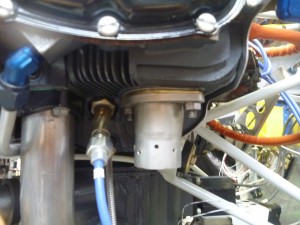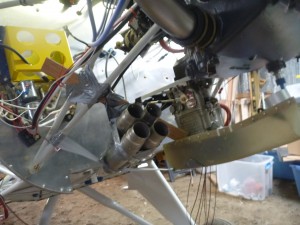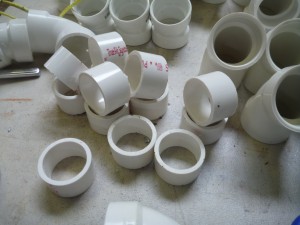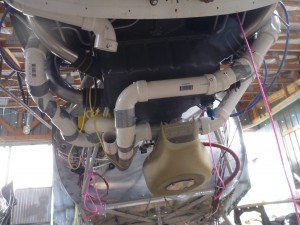Today I was finally able to start on the exhaust system mock up. As you can see in much earlier entries, I started with making an exhaust system out of EMT conduit, like Bob and others have. I wasn’t too pleased with how it was turning out, and I was especially concerned about excess noise and weight. I started looking at how much longer it was going to take to finish the EMT system, compared to how much it would cost to buy a stainless steel system, and realized that it was going to make more sense to go with the stainless system. I first spoke with Vetterman, since he does the exhaust system for nearly all of the RVs, and has a great reputation. He has an associate named Clint who handles all of the work on angle valve engines, which ours is. I spoke with Clint several times about trying to make a system that would incorporate mufflers. He felt very confident that he could make a system with four straight pipes, but could not make a system with mufflers. I was asking Bob Barrows about something else and the topic came up, and he asked if I’d considered a 4 into 1 system. It turns out that Clint doesn’t make those (which is really unfortunate, since I would have been glad to work with him and see him get the business), so I started looking for someone who did. One of my fellow builders suggested aircraftexhaust.net, which is the company that was featured in a Kitplanes article a few years ago. Their business model involves sending out some exhaust flanges welded to stubs, and a collector, all of which are sized to fit inside 1.5″ PVC pipe. Then the airplane builder makes up a PVC version of what the exhaust should be, and sends that to the exhaust fabricator. I especially liked this arrangement, since our engine is very non-standard. It seemed like a good way to be sure that we’d have a finished exhaust that would fit. Back in April I got in touch with the guy who runs that business, with hopes of getting the PVC setup mocked up and back to him so that he could fabricate the system while I was out of town. It turns out that he is quite a fabricator after all, in more ways than one. Fortunately I was able to figure out that he is not reliable before
he had any of my money. A little bit of Googling points to the stories of others who weren’t so lucky. While I didn’t lose any money on that situation, I did lose about a month of progress. I started looking for other companies that could do that sort of work, and then I found sonicheaders.com. There is a fellow there named Todd, and his address is not very far from one of the addresses associated with the other company. His website has pictures of exhaust systems mounted on the same type of jigs as the other company, and the text portion of his website features enough common grammar and spelling anomolies for me to think that they were written by the same person. I was a little bit worried by this, but figured I would call to see what was up. I called him and explained where I was with the situation, and he said that he used to work for the other fellow, and that the other fellow had fallen on some hard times and decided to become dishonest with his customers. He said that he could send the mock-up parts out on that same day, so I gave him my credit card number and waited a few days. The parts came right on schedule, and that leads me to today in the short version of my exhausting exhaust story. I started by going to the local big box store to load up on fittings.

The silver parts in that picture are the parts of the mock-up kit. The fittings that I purchased locally include several 90s, 45s, and 22.5s. The 270s are actually drain traps, but the 180 portion of that fitting was a tighter turn than two 90s together. Also, not pictured, is about 10 feet of straight pipe. First, I bolted the stubs onto the exhaust ports, not forgetting to include gaskets.

Then, I used duct tape and string to try and position the collector about where I wanted it. The challenge was to get each of the four tubes going into the collector to be an equal length, and close to 30 inches. While there is much more room for the collector behind the carb, that location would not have allowed me to get to the number 2 cylinder in 30 inches- it probably would have been more like 40. That cylinder was definitely the limiting factor in collector positioning.

Then I used the chop saw to cut off several short pieces of pipe, which would allow me to but several fittings up against each other.

Then, I just started playing with the pieces to see how it would turn out. It’s a hard job to start- once I got going, it was a lot easier. I just had to jump in and get started, with temporary pipe connections of course. The biggest problem with the whole arrangement was that the collector pipes were so close together. This makes it impossible for PVC to slip around the outside of all four pipes at once. I used the belt sander to remove most of the flanges of the fittings so that they would go together.


I’m going to break the chronology here a little and add in a follow-up from the future, since I can, and since I’m sure you are giddy with suspense about how the exhaust saga ended. The exhaust system turned out pretty well. In retrospect, I wish I had come up with another way to mock up the pipes right as they go into the collector. Maybe a smaller 1″ PVC running to the inside of the collector pipes would have been an option. In the end, I had to make a bump in the cowl to accommodate two of the pipes. I could have made the bump smaller if I had turned the lowest pipe up sooner, which I could have done if I was working with smaller diameter pipe. Todd at Sonic Headers turned out to be an honest fellow and a good welder.
Several circumstances led to delays that were frustrating. First, when I sent the system back, it sat for a week before he got to it, because he didn’t check the mail. He said most folks ship via UPS. Then he didn’t have enough of the tight 90-degree bends, so he had to order more of those from his supplier. I should add tha the builds the system by butt-welding pre-bent pieces, not by starting with one long pipe that gets custom bends. The two-week lead time turned into seven, and he said that he reduced the price a little to account for that. The total cost was still right around $1500. For someone else who is thinking about going with this route, I would suggest first and foremost that you avoid aircraftexhaust.net, since he’s pretty much become a scam artist as far as I can tell. If you go with Todd at Sonic Headers, you can expect a responsive attitude and quality work, but I would do the mock-up process long before you need the pipes, and give him lots of time to get the work done. I should have probably been doing this a year ago, and that would have taken the stress out of much of this process. Here ends the follow-up from the future. Tune in tomorrow to see how the rest of the mockup process went.